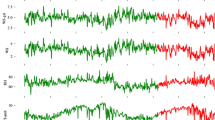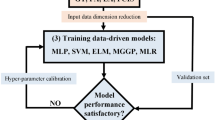Abstract
Solar radiation prediction is necessary for designing photovoltaic systems, assessment of regional climate and crop growth modeling. However, this estimate depends on expensive devices, namely pyranometer and pyranometer. Considering the difficulty of acquiring these devices, predicting such values through mathematical and computational models is a convenient approach where costs can be reduced. In particular, machine learning methods have been successfully and widely applied for this task. However, the choice of the correct machine learning model, its parameters sets, and the variables used influence obtained results. This work presents a methodology that optimizes the aforementioned points to efficiently predict solar radiation in the state of Minas Gerais, Brazil. Currently, no work presents a computational model for the entire state. For this, data from 51 cities in Minas Gerais are used, obtained by the automatic weather stations of the National Institute of Meteorology. Two machine learning models, Artificial Neural Network and Multivariate Adaptive Regression Spline, were optimized through a Simple Genetic Algorithm, and the results compared to those available in the literature. The best results were found at the Guanhães station, with R\(^2\) of 0.867 and RMSE of 1.68 MJ m\(^{-2}\) day\(^{-1}\), and at the Muriaé station, with R\(^2\) of 0.864 and RMSE of 1.64 MJ m\(^{-2}\) day\(^{-1}\). The models had their metrics compared to each other through the methodology of performance profiles, where the Multivariate Adaptive Regression Spline model proved to be more efficient. The results demonstrate that computational models perform better than the empirical models currently used.





Similar content being viewed by others
Availability of data and material
Data and materials can be obtained upon request from the authors.
Code availability
Code can be obtained upon request from the authors.
References
Agência Nacional de Energia Elétrica (2022) Sistema de Informações de Geração da ANEEL. https://app.powerbi.com/view?r=eyJrIjoiNjc4OGYyYjQtYWM2ZC00YjllLWJlYmEtYzdkNTQ1MTc1NjM2IiwidCI6IjQwZDZmOWI4LWVjYTctNDZhMi05MmQ0LWVhNGU5YzAxNzBlMSIsImMiOjR9. Accessed 19 July 2022
Associação Brasileira de Energia Solar Fotovoltaica (2022) Energia Solar Fotovoltaica no Brasil. https://www.absolar.org.br. Accessed 19 July 2022
Attar NF, Sattari MT, Prasad R et al (2022) Comprehensive review of solar radiation modeling based on artificial intelligence and optimization techniques: future concerns and considerations. Clean Techn Environ Policy. https://doi.org/10.1007/s10098-022-02434-7
Barbosa LA, Silva CR, Paula MTG, et al (2011) Estimativa da radiação solar com base na temperatura do ar na região sul, suldeste, oeste de Minas e Campo das Vertentes. In: XVII Congresso Brasileiro de Agrometeorologia, 2011, Guarapari - ES. http://www.sbagro.org/files/biblioteca/3194.pdf
Basílio SCA, Goliatt L (2022) Gradient boosting hybridized with exponential natural evolution strategies for estimating the strength of geopolymer self-compacting concrete. Knowl-Based Eng Sci 3(1):1–16. https://doi.org/10.51526/kbes.2022.3.1.1-16
Basílio SCA, Saporetti CM, Yaseen ZM et al (2022) Global horizontal irradiance modeling from environmental inputs using machine learning with automatic model selection. Environ Dev 44(100):766. https://doi.org/10.1016/j.envdev.2022.100766. https://www.sciencedirect.com/science/article/pii/S2211464522000689
Basílio SCA, Silva RO, Saporetti CM et al (2022) Modeling global solar radiation using machine learning with model selection approach: A case study in tanzania. In: Shakya S, Ntalianis K, Kamel KA (eds) Mobile Computing and Sustainable Informatics. Springer Nature Singapore, Singapore, pp 155–168
Birol F (2021) World Energy Outlook 2021. Tech. rep., International Energy Agency. https://www.iea.org/reports/world-energy-outlook-2021
Biscani F, Izzo D (2020) A parallel global multiobjective framework for optimization: pagmo. J Open Source Softw 5(53):2338
Brasil (2015) PL 1917/2015. https://www.camara.leg.br/proposicoesWeb/fichadetramitacao?idProposicao=1307190. Accessed 18 Jul 2022
Brasil (2019) Portaria n\(^{\circ }\) 465, de 12 de dezembro de 2019. https://www.in.gov.br/en/web/dou/-/portaria-n-465-de-12-de-dezembro-de-2019.-233554889. Accessed 18 Jul 2022
Brasil (2021) PL 414/2021. https://www.camara.leg.br/proposicoesWeb/fichadetramitacao?idProposicao=2270036. Accessed 18 Jul 2022
Carvalho FJ, Silva CR, Nascimento HF, et al (2011) Avaliação de modelos de estimativa da radiação solar com base na temperatura do ar para o norte de Minas Gerais. In: XVII Congresso Brasileiro de Agrometeorologia, 2011, Guarapari - ES. http://www.sbagro.org/files/biblioteca/3179.pdf
Castro JRd, Cuadra SV, Pinto LB et al (2018) Parametrization of models and use of estimated global solar radiation data in the irrigated rice yield simulation. Rev Bras Meteorol 33(2):238–246
Cheng MY, Cao MT (2014) Accurately predicting building energy performance using evolutionary multivariate adaptive regression splines. Appl Soft Comput 22:178–188
Cifuentes J, Marulanda G, Bello A, et al (2020) Air temperature forecasting using machine learning techniques: A review. Energies 13(16). https://doi.org/10.3390/en13164215. https://www.mdpi.com/1996-1073/13/16/4215
Cunha AC, Filho LRAG, Tanaka AA et al (2021) Performance and estimation of solar radiation models in state of minas gerais, brazil. Model Earth Systems Environ 7(1):603–622. https://doi.org/10.1007/s40808-020-00956-x
Dantas AAA, de Carvalho LG, Ferreira E (2003) Estimativa da radiação solar global para a região de lavras, mg global solar radiation estimation in lavras region, mg. Ciência e agrotecnologia 27(6):1260–1263
Dolan ED, Moré JJ (2002) Benchmarking optimization software with performance profiles. Math Program 91(2):201–213. https://doi.org/10.1007/s101070100263
Fan J, Wu L, Ma X et al (2020) Hybrid support vector machines with heuristic algorithms for prediction of daily diffuse solar radiation in air-polluted regions. Renew Energy 145:2034–2045
Ferreira LB, da Cunha FF, de Oliveira RA et al (2019) Estimation of reference evapotranspiration in brazil with limited meteorological data using ann and svm - a new approach. J Hydrol 572:556–570. https://doi.org/10.1016/j.jhydrol.2019.03.028. https://www.sciencedirect.com/science/article/pii/S0022169419302689
Ferreira LB, da Cunha FF, Fernandes Filho EI (2022) Exploring machine learning and multi-task learning to estimate meteorological data and reference evapotranspiration across brazil. Agric Water Manag 259(107):281. https://doi.org/10.1016/j.agwat.2021.107281. https://www.sciencedirect.com/science/article/pii/S0378377421005588
Finzi RR, Silva CR, Carvalho FJ, et al (2011) Estimativa da radiação solar baseando-se na temperatura máxima e mínima do ar para a região noroeste de Minas Gerais. In: XVII Congresso Brasileiro de Agrometeorologia, 2011, Guarapari - ES. http://www.sbagro.org/files/biblioteca/3176.pdf
Friedman JH (1991) Multivariate adaptive regression splines. Ann Stat 19(1):1–67. https://doi.org/10.1214/aos/1176347963
Gardner M, Dorling S (1998) Artificial neural networks (the multilayer perceptron)–a review of applications in the atmospheric sciences. Atmos Environ 32(14):2627–2636. https://doi.org/10.1016/S1352-2310(97)00447-0. www.sciencedirect.com/science/article/pii/S1352231097004470
Goliatt L, Yaseen ZM (2023) Development of a hybrid computational intelligent model for daily global solar radiation prediction. Expert Syst Appl 212(118):295. https://doi.org/10.1016/j.eswa.2022.118295. www.sciencedirect.com/science/article/pii/S0957417422014300
Hai T, Sharafati A, Mohammed A, et al (2020) Global solar radiation estimation and climatic variability analysis using extreme learning machine based predictive model. IEEE Access 8:12,026–12,042
Instituto Brasileiro de Geografia e Estatística (2022) Produto Interno Bruto - PIB. https://www.ibge.gov.br/explica/pib.php. Accessed 19 July 2022
Instituto Nacional de Meteorologia (2022). http://portal.inmet.gov.br/. Accessed 15 June 2022
Khosravi A, Machado L, Nunes R (2018) Time-series prediction of wind speed using machine learning algorithms: A case study osorio wind farm, brazil. Appl Energy 224:550–566. https://doi.org/10.1016/j.apenergy.2018.05.043. www.sciencedirect.com/science/article/pii/S0306261918307360
Lan H, Yin H, Hong YY et al (2018) Day-ahead spatio-temporal forecasting of solar irradiation along a navigation route. Appl Energy 211:15–27. https://doi.org/10.1016/j.apenergy.2017.11.014. www.sciencedirect.com/science/article/pii/S0306261917315945
Martinho AD, Ribeiro CBM, Gorodetskaya Y et al (2020) Extreme learning machine with evolutionary parameter tuning applied to forecast the daily natural flow at cahora bassa dam, mozambique. In: Filipič B, Minisci E, Vasile M (eds) Bioinspired Optimization Methods and Their Applications. Springer International Publishing, Cham, pp 255–267
Martinho AD, Fonseca TL, Goliatt L (2021) Automated extreme learning machine to forecast the monthly flows: A case study at zambezi river. In: Abraham A, Piuri V, Gandhi N et al (eds) Intelligent Systems Design and Applications. Springer International Publishing, Cham, pp 1314–1324
Ministério de Minas e Energia (2018) Potencial dos Recursos Energéticos no Horizonte 2050. Tech. rep., Empresa de Pesquisa Energética. https://www.epe.gov.br/sites-pt/publicacoes-dados-abertos/publicacoes/PublicacoesArquivos/publicacao-227/topico-416/NT04%20PR_RecursosEnergeticos%202050.pdf
Monteiro AFM, Martins FB (2019) Global Solar Radiation Models in Minas Gerais. Southeastern Brazil. Adv Meteorol 2019:9515430. https://doi.org/10.1155/2019/9515430
Moraes RA, Miranda WL (2013) Avaliação dos dados decendiais de precipitação, temperatura média, máxima e mínima do ar, radiação solar e evapotranspiração de referência simulados pelo modelo ecmwf para Minas Gerais. In: XVIII Congresso Brasileiro de Agrometeorologia, 2013, Belém - PA. http://www.sbagro.org/files/biblioteca/2855.pdf
Obando ED, Carvajal SX, Pineda Agudelo J (2019) Solar radiation prediction using machine learning techniques: A review. IEEE Lat Am Trans 17(04):684–697. https://doi.org/10.1109/TLA.2019.8891934
Paula MTG, Silva CR, Silva VJ, et al (2011) Estimativa da radiação solar através dos valores de temperatura registrados na região nordeste de Minas Gerais. In: XVII Congresso Brasileiro de Agrometeorologia, 2011, Guarapari - ES. http://www.sbagro.org/files/biblioteca/3183.pdf
Pedregosa F, Varoquaux G, Gramfort A et al (2011) Scikit-learn: Machine learning in Python. J Mach Learn Res 12:2825–2830
Ramos JPA, Vianna MDS, Marin FR (2018) Estimativa da radiação solar global baseada na amplitude térmica para o brasil. Agrometeoros 26(1). https://doi.org/10.31062/agrom.v26i1.26299
Rodríguez F, Martín F, Fontán L et al (2021) Ensemble of machine learning and spatiotemporal parameters to forecast very short-term solar irradiation to compute photovoltaic generators’ output power. Energy 229(120):647. https://doi.org/10.1016/j.energy.2021.120647. www.sciencedirect.com/science/article/pii/S0360544221008963
Salcedo-Sanz S, Casanova-Mateo C, Pastor-Sánchez A et al (2014) Daily global solar radiation prediction based on a hybrid coral reefs optimization - extreme learning machine approach. Sol Energy 105:91–98
Santos MVC, Carvalho ALd, Souza JLd, et al (2020) A modelling assessment of the maize crop growth, yield and soil water dynamics in the northeast of brazil. Aust J Crop Sci (14(6):2020):897–904
Silva CRd, Silva VJd, Alves Júnior J et al (2012) Radiação solar estimada com base na temperatura do ar para três regiões de minas gerais. Rev Bras Engenharia Agric Ambient 16(3):281–288
Silva VJd, Silva CRd, Finzi RR et al (2012) Métodos para estimar radiação solar na região noroeste de minas gerais. Cienc Rural 42(2):276–282
Souza DPM, Martinho AD, Rocha CC et al (2022) Hybrid particle swarm optimization and group method of data handling for short-term prediction of natural daily streamflows. Model Earth Syst Environ. https://doi.org/10.1007/s40808-022-01466-8
Srinivas M, Patnaik L (1994) Genetic algorithms: a survey. Computer 27(6):17–26. https://doi.org/10.1109/2.294849
Tao H, Ewees AA, Al-Sulttani AO et al (2021) Global solar radiation prediction over north dakota using air temperature: Development of novel hybrid intelligence model. Energy Rep 7:136–157
Tiba C, Reis RR, Costa JC et al (2014) On the development of spatial/temporal solar radiation maps: A minas gerais (brazilian) case study. J Geogr Inf Syst 06(03):258–274. https://doi.org/10.4236/jgis.2014.63024
Wu Z, Cui N, Gong D et al (2022) Predicting daily global solar radiation in various climatic regions of china based on hybrid support vector machines with meta-heuristic algorithms. J Clean Prod 385:135589. https://doi.org/10.1016/j.jclepro.2022.135589; https://www.sciencedirect.com/science/article/pii/S0959652622051630
Zhou Y, Liu Y, Wang D et al (2021) A review on global solar radiation prediction with machine learning models in a comprehensive perspective. Energy Convers Manag 235(113):960
Zuluaga CF, Avila-Diaz A, Justino FB et al (2022) The climate change perspective of photovoltaic power potential in brazil. Renew Energy 193:1019–1031. https://doi.org/10.1016/j.renene.2022.05.029. www.sciencedirect.com/science/article/pii/S096014812200670X
Funding
The authors acknowledge the support of the Computational Modeling Graduate Program at Federal University of Juiz de Fora (UFJF), the Federal Center for Technological Education of Minas Gerais (CEFET-MG), and the Brazilian funding agencies CNPq - Conselho Nacional de Desenvolvimento Científico e Tecnológico (grants 307688/2022-4 and 401796/2021-3), FAPEMIG - Fundação de Amparo a Pesquisa do Estado de Minas Gerais (grant number APQ-00334/18), and CAPES - Coordenação de Aperfeiçoamento de Pessoal de Nível Superior, (finance code 001).
Author information
Authors and Affiliations
Contributions
The development, execution and analysis of the proposed framework were performed by Samuel da Costa Alves Basílio and Leonardo Goliatt da Fonseca. Angélica Carvalho Cunha and Fernando FErrari Putti performed the data collection. The first draft of the manuscript was written by Samuel da Costa Alves Basílio and all authors commented on previous versions of the manuscript. All authors read and approved the final manuscript.
Corresponding author
Ethics declarations
Conflict of Interest/Competing Interest
The corresponding author states that there is no conflict of interest on behalf of all authors.
Additional information
Communicated by H. Babaie.
Publisher's Note
Springer Nature remains neutral with regard to jurisdictional claims in published maps and institutional affiliations.
Rights and permissions
Springer Nature or its licensor (e.g. a society or other partner) holds exclusive rights to this article under a publishing agreement with the author(s) or other rightsholder(s); author self-archiving of the accepted manuscript version of this article is solely governed by the terms of such publishing agreement and applicable law.
About this article
Cite this article
Basílio, S.d.C.A., Putti, F.F., Cunha, A.C. et al. An evolutionary-assisted machine learning model for global solar radiation prediction in Minas Gerais region, southeastern Brazil. Earth Sci Inform 16, 2049–2067 (2023). https://doi.org/10.1007/s12145-023-00990-0
Received:
Accepted:
Published:
Issue Date:
DOI: https://doi.org/10.1007/s12145-023-00990-0




